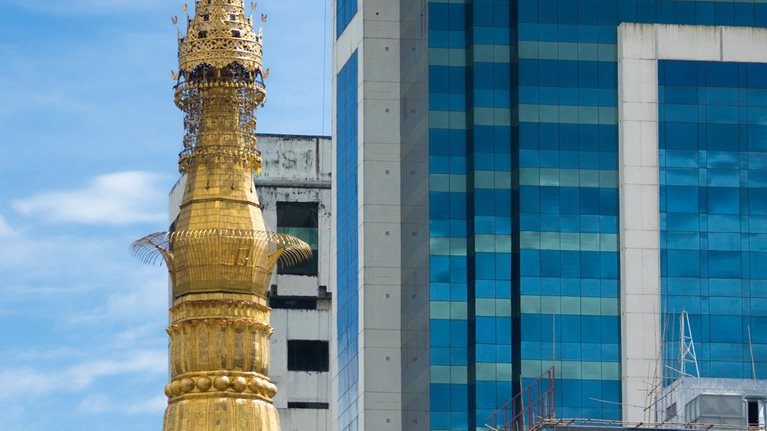Eight reasons to be optimistic about Southeast Asia's rising tiger.
Myanmar is attracting a lot of attention these days. The visit by President Thein Sein to Washington in May, the first by a leader of Myanmar since 1966, included a meeting with President Barack Obama — marking an emphatic end to the years of international isolation. But it is not only Myanmar's change of political direction that is exciting interest. Thein Sein's itinerary also included a U.S. Chamber of Commerce fete with top American executives. Economic opportunity has U.S. and Western multinationals licking their lips. International investors are actively circling this largely untapped market. And the doors are wide open. On June 5-7, Myanmar plays host to the World Economic Forum, the first leading international gathering of senior decision-makers from industry, government, academia, and civil society to be held there.
But it's easy to make the case that the current hype on Myanmar has run ahead of the reality.
After all, between 1900 and 1990, gross domestic product (GDP) growth appears to have increased at no more than 1.6 percent a year — half of the rate of the rest of the world. And per capita GDP did not increase at all in this period, while globally it quadrupled. As a result, today Myanmar accounts for only 0.2 percent of Asia's GDP — which, for comparison, put's the entire country's economy about that of Omaha, Nebraska or Fresno, California. Moreover, incomes are still low. Only 2.5 million, or 4 percent, of Myanmar's citizens today have enough income to spend on discretionary items — globally the average is 35 percent. Unlike other countries in Asia, Myanmar has become more, not less, dependent, on agriculture. Agriculture's share of GDP rose from 35 percent in 1965 to 44 percent in 2010, a period during which the share fell sharply across Asia to an average of only 12 percent. Meanwhile, other indicators still lag: the U.N. Development Programme estimates that the average citizen in Myanmar has only four years of schooling. And labor productivity is only 30 percent that of neighboring Asian countries. If productivity growth remains on the path of the past 20 years, annual GDP growth could be less than 4 percent.
Despite this low starting point, there's much to be optimistic about in Myanmar. Here are eight reasons why the country could be on the cusp of a new boom:
1. There's no need to reinvent the wheel
A tried and tested development path already exists. The experience of other emerging Asian economies shows that it is possible for Myanmar to grow very quickly if it diversifies from agriculture, urbanizes, and makes significant productivity gains within different sectors. Incomes in developing economies are rising faster than at any other point in history. Globally, the average time it takes to double per capita GDP at purchasing power parity from $1,300 —Myanmar's level today — has dropped dramatically. During the British Industrial Revolution, starting in the 18th century, it took 150 years to see such gains in living standards; by the 1960s it was down to 47 years; since 2000, it's dropped to 17 years. In booming Asian economies like Vietnam and China, it has taken just 11 and 12 years respectively to double average incomes.
2. Close to big and growing markets
Myanmar is fortunate in its location. It borders Bangladesh, China, India, Laos, and Thailand which puts it in close proximity to a market of more than half a billion people. Many of these markets are growing rapidly, giving Myanmar a large export opportunity at a time when Asia's economy is integrating. ASEAN's free trade zone is due to start at the end of 2015. In addition, it will be within a five-hour plane ride of a market of two and a half billion potential tourists by 2025.
3. Abundant natural resources
Myanmar may have suffered under a military dictatorship for decades, but it's been blessed with plenty: from oil to timber, gas to water. Although the onset of Asian shale could mean falling prices for Myanmar's natural gas, it remains the case that its reserves are large. BP estimates that proven natural gas reserves total 7.8 trillion cubic feet, the 46th largest reserves in the world. The country also has oil reserves, though the scale is difficult to estimate because exploration has been so limited. Myanmar accounts for 90 percent of the world's production of jade and is one of the world's top producers of gems including rubies and sapphires. And the country boasts the 25th largest area of agricultural land in the world.
4. It's not just resources
Our research suggests that seven key sectors of the economy — manufacturing, agriculture, infrastructure, energy and mining, tourism, financial services, and telecoms — could quadruple the size of Myanmar's economy from $45 billion today to more than $200 billion in 2030 and create 10 million new jobs outside agriculture. The number of consumers with discretionary spending could rise from 2.5 million to 19 million, tripling consumer spending to $100 billion. To achieve this feat, Myanmar would have to more than double labor productivity growth from 2.7 percent today to 7 percent — but that's not unprecedented within Asia (for example, Thailand and China have achieved such levels of growth). If it does so, the economy could conceivably grow at 8 percent a year.
5. A relatively large workforce
Myanmar has another useful resource — its people. The country has an estimated working-age population of 46 million. And low wages could make it an attractive destination for manufacturing. But to power growth, they will need more semi-skilled and skilled labor. Thankfully, there's a ready solution to kick start this process — a diaspora of between three and five million people, many of whom have built up skills and experience working overseas. Persuade some of these citizens to come home, and that would bring an immediate injection of skills and dynamism into the economy. Even if they remain overseas, they could potentially become major investors in Myanmar's economy. Consider this: overseas Chinese contributed about 70 percent of China's foreign direct investment between 1985 and 2000.
6. From fields to cities
Myanmar remains an overwhelmingly agricultural and rural economy — another growth opportunity. Emerging economies that have diversified away from agriculture and whose populations have migrated to urban environments have posted rapid growth. While the rest of Asia has been urbanizing at unprecedented speed and scale, only about 13 percent of Myanmar's citizens live in large cities. Aside from the two large cities Yangon and Mandalay, only eight cities in Myanmar have reached population levels exceeding 200,000, compared with 32 such cities in Thailand and 16 in Vietnam. But if Myanmar is to increase the speed of its development, it needs to begin to support a shift into manufacturing that will bring people into its cities — a migration that would power growth, incomes, and jobs.
7. Harnessing the digital age
Myanmar is embarking on its economic transformation at a time when mobile and Internet technologies are ubiquitous and more affordable than ever. Studies have shown a direct correlation between technology, innovation, and economic growth. For instance, in a study of 120 low- and middle-income countries, the World Bank found that a 10 percent increase in broadband penetration between 1980 and 2002 correlated with an additional 1.38 percent in GDP growth. Myanmar could well be the test case for the power of digital technology to turbo-charge economies. By harnessing technology in a coordinated effort across the key areas of government, education, health care, banking, and retail, Myanmar could potentially become one of the fastest-growing economies in the world.
8. Friends in high places
From Brussels to Washington, Western leaders have stepped forward to support Myanmar's fledgling democracy, ending years of isolation. Meanwhile, the country is garnering considerable support from multilateral institutions and donors: last year, the World Bank resumed lending to the country and opened an office in Yangon. Economic sanctions are being lifted progressively, foreign governments have opened embassies after many years of absence, and dozens of trade delegations have visited Myanmar in the past year alone. Reintegration into the global community will have untold dividends.
* * *
And yet Myanmar's years of economic under-performance are a double-edged sword. On one hand, the government has to address virtually every aspect of the economy — as well as sustain political reform and resolve lingering ethnic conflict, both of which make investors nervous — at once. On the other, there is a virtually blank slate on which to write the nation's new chapter. Myanmar can build infrastructure and public services from scratch, fit for the purpose of the modern world. Clearly, dangers lurk in the unknown corners of this still opening nation. But today's hype about this small, under-developed economy could prove wholly justified — indeed, it could be much bigger than anyone thinks.
This article originally ran in Foreign Policy.


